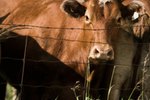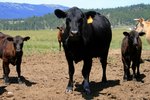The digestive system of ruminants — hoofed mammals such as cattle, deer, goats, giraffes and sheep — is regulated by a stomach with four compartments: the reticulum, omasum, abomasum and rumen. Each compartment serves a different function, enabling the ruminant to maintain its cud-chewing, which involves regurgitated food. The rumen is the largest of the four compartments, and it has several important functions related to digestion.
Fermentation
The rumen stores food that a ruminant regurgitates, chews again and swallows a second time. Ruminants can chew their cud for hours every day. The rumen houses many tiny organisms which aid in the digestion of food such as hay and grass. The rumen ferments this food through the creation of gas, which it must expel by belching to prevent bloating. Gas in the rumen is composed of carbon dioxide and methane, and as many as 260 gallons of gas is expelled by a ruminant on a daily basis.
Mixing
The muscles of the rumen aid in the mixing of the food and help make the regurgitated food easier to chew. The walls of the rumen contain ruminal papillae, which are tiny organs that aid in absorption of food. The number of papillae is directly related to the dietary habits of the ruminant. A diet rich in grains stimulates papillae growth and increases their size.
Conversion
More than 150 billion micro-organisms exist in the rumen, helping to turn the carbohydrates in a ruminant's food into volatile fatty acids, which provide more than 70 percent of the mammal's energy supply. These organisms include bacteria, protozoa and fungi. The bacteria in the rumen converts protein into keto acids and ammonia, which it uses to build protein for nourishment to grow stronger.
Growth and Physiology
The rumen is a not functional when a ruminant is born and does not fully develop for six to nine months. The rumen can hold as many as 50 gallons in a normal-sized cow. Gases rise to the upper portion of the organ and food items such as grain and hay eaten the previous day, go to the bottom. The middle section of the rumen is filled with hay eaten the same day. Water moves through the rumen at a high rate of speed. However, food and other material takes time due to denser composition.
References
Photo Credits
-
BananaStock/BananaStock/Getty Images
Writer Bio
Sampson Quain is a screenwriter and filmmaker who began writing in 1996. He has sold feature and television scripts to a variety of studios and networks including Columbia, HBO, NBC, Paramount and Lionsgate. He holds a Master of Fine Arts in screenwriting from the University of Southern California.





